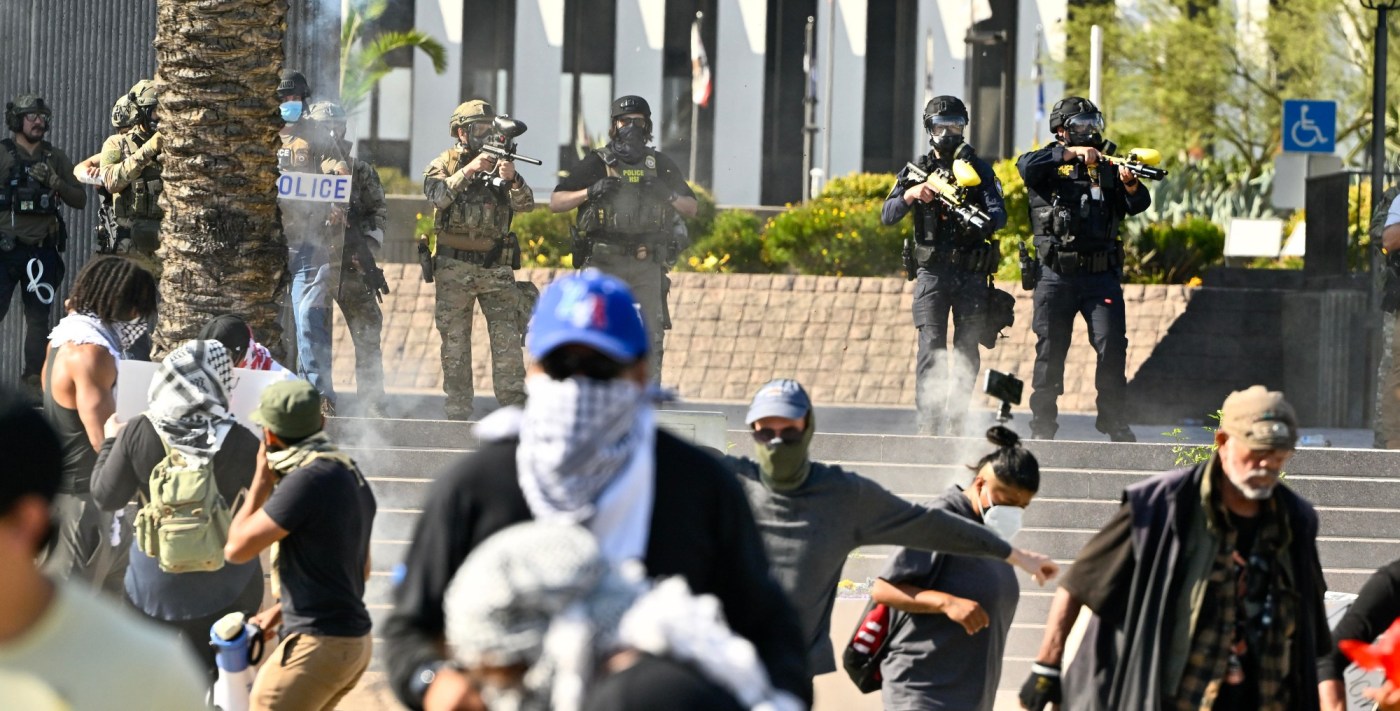For the first time in three years, community members and city leaders weighed in on the Santa Ana Police Department’s military equipment policy.
The discussion followed the department’s admission that it had violated AB 481, a 2022 state transparency law that provides oversight on the use and procurement of equipment such as less-lethal devices and armored rescue vehicles. It requires law enforcement agencies to publish annual reports, hold community meetings and obtain local government approval for the proposed use of military gear.
The Santa Ana department had done none of those things.
Chief Robert Rodriguez attributed the department’s noncompliance to “administrative oversight” relating to turnover.
“We were transitioning from a different leadership at the Police Department, and not just the Police Department, but also at the city,” said Rodriguez, who was sworn in as chief in December 2024 after the retirement of Chief David Valentin. “I believe in 2024, we had three city managers.”
“I made it a top priority to make sure that we were in compliance with the community meeting, and bringing it forward to council,” he added. “This was something that we brought forward ourselves, and it was in the interest of ensuring we were compliant and transparent with AB 481.”
The lack of reporting and outreach on the policy is “exactly why Santa Ana needs our independent, investigatory oversight commission,” said Chispa Policy and Political Director Bulmaro Vicente, who was at the recent community meeting on the military equipment use when police officials said they had dropped the ball on compliance. Chispa advocated for the commission’s creation in 2022.
“The commission should not only ensure compliance with AB 481,” he said, “but also review and make recommendations on the city’s military equipment policy. Leaving it up solely to council has failed our community.”
Rodriguez said the issue of noncompliance was resolved after the department published its annual reports for 2022-23 and 2023-24 in March and the 2024-25 report in July. Some takeaways from those reports:
- 2022-23: Police deployed the use of military equipment 19 times, and those situations resulted in 16 people detained or arrested. Use of force was reported for three of those incidents.
- 2023-24: Police deployed the use of military equipment 69 times, which resulted in 56 people detained or arrested. Use of force was reported twice.
- 2024-25: Police deployed the use of military equipment 30 times, which resulted in 21 people detained or arrested. Six of those encounters resulted in police using the equipment as a “less-lethal force option to de-escalate the situation,” authorities said.
The most recent report covers events through April 30, just a month before a weekend of coordinated immigration enforcement raids in Los Angeles and the deployment of the National Guard ignited protests in Santa Ana in early June.
But another 2022 state law sheds light on what military equipment was used during the week of June protests in Santa Ana. It requires police agencies to publicly report when a kinetic energy projectile, which shoots rubber or plastic bullets, or chemical agent is utilized for crowd control. It also restricts the use of less-lethal weapons, such as tear gas, pepper spray and rubber bullets, unless other measures are exhausted, and police believe the use can defend against a threat to life or serious injury.
According to those reports:
- June 9: Multiple law enforcement agencies assisted Santa Ana PD during an anti-ICE immigration enforcement protest in downtown. Authorities shot 105 rounds from a Direct Impact 40 mm and deployed 29 rounds of a CS chemical agent.
- June 10: Police fired 19 rounds of kinetic munition from a 12-gauge shotgun, 23 rounds from a Direct Impact 40 mm, and deployed 6 CS chemical agents.
- June 11: Police fired 28 rounds of kinetic munition from a 12-gauge shotgun and 42 sponge rounds from a Direct Impact 40 mm.
- June 14: Police shot 45 sponge rounds from a Direct Impact 40 mm and 12 kinetic munition rounds from a 12-gauge shotgun.
A community meeting was held Aug. 13 to discuss the annual reports — they had been presented to the city’s police oversight commission in April — and the City Council discussed them last week.
Councilmember Jessie Lopez and members of the Latin political advocacy group Chispa attended the recent community meeting. Lopez and community advocates provided feedback to the Police Department on ways to improve future meetings and reports.
At the council session on Aug. 19, city officials split on whether to review, reject or maintain the department’s existing policy on military equipment. Councilmember Johnathan Hernandez sought to reject the military equipment ordinance and Lopez wanted to review the policy, but in the end, Mayor Valerie Amezcua and councilmembers Phil Bacerra, Thai Viet Phan, David Penaloza voted to keep the policy as it was.
Separately, plans for a special joint meeting between the City Council and the Police Oversight Commission to discuss the commission’s independence appear to have fallen through. The meeting was agreed to by the City Council after the city manager’s office submitted proposed changes to the ordinance that created the commission for review, which included the removal of the word “independent” throughout.
City staff told councilmembers last week they were unable to coordinate a time that worked for all 14 people involved.
Commissioners will instead make recommendations on the proposed ordinance amendments at their next meeting, scheduled for Sept. 11. The City Council will then review those Sept. 16 and decide how to move forward.
